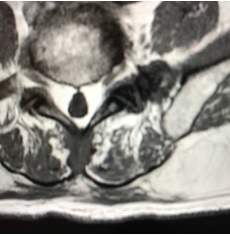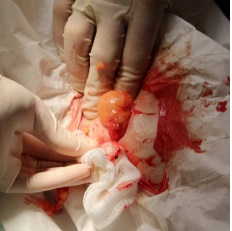Episacral Lipomas
Original Editor - Rewan Aloush
Top Contributors - Rewan Aloush, Kim Jackson and Lucinda hampton
Introduction[edit | edit source]
Episacral lipoma is a small, tender subcutaneous nodule primarily occurring over the posterior iliac crest. Episacral lipoma is a significant and treatable cause of acute and chronic low back pain. Episacral lipoma occurs as a result of tears in the thoracodorsal fascia and subsequent herniation of a portion of the underlying dorsal fat pad through the tear. This clinical entity is common, and recognition is simple. [1]
Other terms for the episacral lipoma are the back mouse, iliac crest pain syndrome and multifidus triangle syndrome.
The "mass" is usually palpable as a mobile soft tumor that splis beneath the examining finger. the treatment ranges from ignoring the lesion as insignificant to multiple puncturing and injection of the nodule with local anethetic, followed by massage. surgical removal does not seem justified because of the uncertainty regarding the significance of these lipoma. A less common area of pain is the normal presacral fat pad. The patient is most often female, and the pain may be related to the menstural cycle. There may even be complaints of a sanse of "swelling" in the area, although none is usually present on examination. Most likely, pain in this normal fat pad is referred from elsewhere, but the cause remains obscure.[2]
Clinical Picture[3][edit | edit source]
A lipoma is abenign tumor made of fat tissue They are generally
- soft to the touch,
- movable,
- painless.
- They usually occur just under the skin but occasionally may be deeper.
- Most are less than 5 cm in size
Risk Factors[edit | edit source]
- Family history,
- Obesity
- Lack of exercise
Causes[edit | edit source]
It’s not clear for sure what causes them.
- Middle-aged men and women tend to get them more, and they run in families.
- They often appear after an injury, though doctors don’t know whether that’s what makes them form.
- Inherited conditions can bring them on. Some people who have a rare condition known as Madelung’s disease can get them. This most often affects alcoholic men of Mediterranean ancestry.
Symptoms[edit | edit source]
They usually appear as small, soft lumps. They’re usually less than 2 inches wide. Sometimes, more than one will develop.
When you press on one, it may feel doughy. It will move easily with finger pressure. They don’t normally hurt, though they can cause pain if they bump up against nearby nerves or have blood vessels running through them.
Diagnosis[edit | edit source]
Diagnosis is typically based on
- Occasionally medical imaging
2.Tissue biopsy is used to confirm the diagnosis.
3. Physical exam.
Treatment[edit | edit source]
Since lipomas aren’t harmful, many times doctor will leave them alone. You may be asked to keep an eye on it between visits.[4]
Small Lipomas[edit | edit source]
If painful can take it out surgically with a small cut.
Other possible treatments include:
- Steroids
- Liposuction
Large Lipomas[edit | edit source]
Lipomas bigger than 2 inches are sometimes called “giant lipomas.” They can cause nerve pain, make you feel self-conscious about your looks, or make it harder for clothes to fit.
It’s a little harder to take out one of these. You most likely would need to be given something that will make you sleep during the procedure. In this case, you’d have to ask someone to drive you home afterward.
Lipomas rarely come back once removed and don’t make it more likely that you’ll get other diseases.
Physical Therapy Management[edit | edit source]
Aims of treatment:
- Temporary pain releif in acute cases
- Muscle and lower limb movement reeducation in a chronic case whether the movements might had been limited due to pain for a long period.
Treatment can be achieved by:
- Deep frictions
- Manipulations should be my means of treatment for pain relief. [5]
- Trigger point therapy.
- Electrical stimulation performed in a "surrounding" distribution, with the lipoma in the center of a circle of points.
Treatment of lipoma naturally:[6][edit | edit source]
Treating Lipomas with Natural Oils and Herbs[edit | edit source]
- Create an ointment using natural oils and herbs. Natural oils such as neem and flaxseed make excellent base for ointments. Experiment with different combinations of herbs and oils.
- Neem oil is an astringent that helps protect your skin. It is commonly used in Ayurvedic (ancient Indian) medicine to treat lipomas.
- Flaxseed oil has high levels of omega-3 and omega-6 fatty acids. Omega-3 and omega-6 fatty acids help to reduce inflammation. Be sure to buy flaxseed oil certified to be free of heavy metals, such as lead and mercury.
- While not a natural oil, cooled green tea is a great alternative for your base. It is high in antioxidants that help regulate blood sugar and blood fats.
2. Mix chickweed with a natural oil or tea base. Blend 1 teaspoon of chickweed to 2-3 tablespoons of neem oil or flaxseed oil. Apply the salve to the lipoma.
- Chickweed is used to reduce fats
- You can also use 1-2 tablespoons of cooled green tea instead of neem or flaxseed oil to make a paste.
3. Try creating an ointment with turmeric. Put 1 teaspoon of turmeric together with 2-3 tablespoons of neem oil or flaxseed oil. Smooth the ointment onto the lipoma. Your skin will turn a bit orange or yellow because of the turmeric. Cover the lipoma with a bandage to protect your clothes.
- Turmeric, like neem oil, is commonly used in Ayurvedic medicine.
- For a paste, add 1-2 tablespoons of cooled green tea instead of neem or flaxseed oil to the turmeric.
4. Add dried sage to neem oil or flaxseed oil. Mix ½ to 1 teaspoon of dried sage with 2-3 tablespoons of neem oil or flaxseed oil. Coat the lipoma with the balm.
- Substitute 1-2 tablespoons of cooled green tea for neem or flaxseed oil to make a paste.
- Sage is used in traditional Chinese medicine to dissolve fatty tissue.
Treating Lipoma with Diet Improvements[edit | edit source]
- Switch to organic foods as much as possible. Switching to organic foods reduces the number of preservatives and additives you eat. Your liver will then be able to focus on removing the toxins stored in the lipoma’s fatty tissue.
- Limiting the amount of processed and pre-packaged food you eat will also limit the amount of additives and preservatives you eat.
2. Increase the amount of vegetables and fruits in your diet. Fruits and vegetables have antioxidants which help lower fats in the blood.
- Choose brightly colored fruits and vegetables for the highest level of antioxidants. Some great examples of fruits and vegetables high in antioxidants are blueberries, raspberries, apples, plums, citrus fruits, leafy green vegetables, squash and bell peppers.
3. Eat more fish. Fish has good amounts of healthy omega-3 fats and good quality protein. Omega-3 fats help to decrease inflammation and may help limit the growth of lipomas.
- Salmon and tuna are excellent sources of omega-3 fatty acids as well as high in protein.
- Good sources of omega-3 fatty acids include mackerel, herring, trout, which are also high in vitamin B-12
4. Limit eating red meats. If you do eat red meat, make sure it is grass-fed with no added antibiotics or hormones. Grass-fed meat has a lot of healthy omega-3 and omega-6 fats.
- Chicken, tofu, and beans are all healthy alternatives to red meat that are also high in protein.
Refrences[edit | edit source]
- ↑ Department of Physical Medicine and Rehabilitation, Ankara Training and Research Hospital, Ankara, Turkey,PubMed ,2013
- ↑ Mercier.L ,Practical Orthopedics 6th Edition, Elsevier
- ↑ James, William D.; Berger, Timothy G.; Elston, Dirk M. (2005). Andrews' Diseases of the Skin: Clinical Dermatology (10th ed.). London: Elsevier
- ↑ Jaliman.D,Web MD, https://www.webmd.com/skin-problems-and-treatments/what-is-a-lipoma#1 last acess 9/2/2018
- ↑ Bond.D, Chiropractic Treatment of the Back Mouse,Dynamic Chiropractic ,September 27, 2004, Vol. 22, Issue 20
- ↑ How to cure lipomas Naturally. WikiHow,https://www.wikihow.com/Cure-Lipomas-Naturally , last access 9/2/2018








